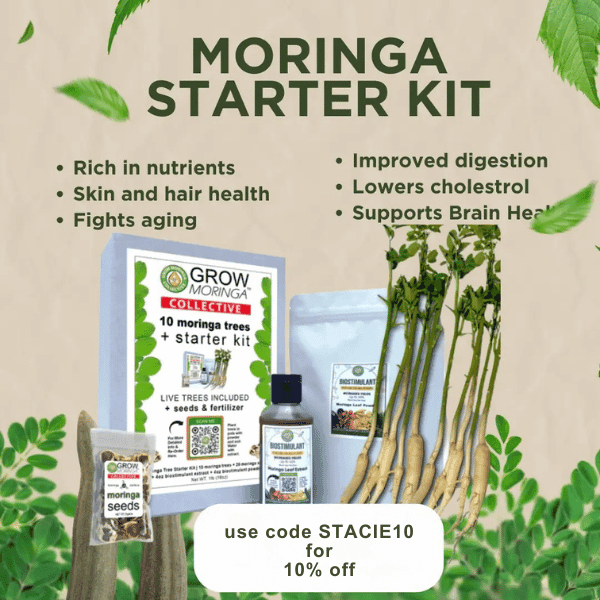If you’re loving moringa powder, why not grow your own? Nothing beats snipping fresh, nutrient-packed leaves right from your garden or balcony! Growing moringa from seed is surprisingly easy and incredibly rewarding, once you see those delicate shoots push through the soil.
In this beginner-friendly guide, I’ll Walk you through how to start growing moringa from seed step-by-step, what tools and conditions you’ll need, and even how to turn your harvest into DIY moringa powder. Whether you’re a seasoned herbalist or a curious plant parent, you’ll be ready to nurture your own superfood tree in no time.
Thinking of turning your garden into income? Learn how to start a moringa business from home →
What a Fully Grown Moringa Looks Like

Why Grow Moringa?
If you’re considering growing moringa from seed, the benefits go beyond health, there’s sustainability, freshness, and full control.
- Freshness: Enjoy the purest, most potent leaves, straight from your own plant.
- Nutrition: Moringa is rich in protein, antioxidants, vitamins, and minerals.
- Sustainability: It’s a drought-tolerant, fast-growing tree, ideal for eco-conscious gardens.
- Control: When you grow your own moringa from seed, you know exactly what you’re getting, no additives, no sprays, no mystery.
Quick-Start: What You’ll Need
- Start with fresh, viable seeds from a trusted source, like Grow Moringa for direct-from-farm freshness (STACIE10 saves 10%) or grab Amazon seeds for fast delivery and convenience.
- Moringa Starter Kit: 10 Trees + Guide
- Deep containers or pots (see Amazon picks)
- Well-draining potting mix (shop Amazon)
- Watering can or mister (shop Amazon)
- Sunny spot or grow light (best grow lights for herbs)
- Organic BioStimulant Powder & Extract

Increase fruit & veggie yields up to 40% using organic moringa! This kit works on all plants ,from leafy greens to fruit trees, and comes with:
- 8oz Moringa Powder (soil booster)
- 16oz Extract (spray for growth)
- 20 Moringa Seeds + Guide
Is Moringa Right for Your Garden?

- USDA Zones 10–11: Grow outdoors year-round in warm, tropical conditions.
- Zones 7–9: Use containers and bring plants indoors when temps fall below 50°F (10°C).
- Colder climates: Grow moringa indoors with strong grow lights or a mini greenhouse setup.
Tip: Even if you have no yard, moringa can thrive on balconies, patios, or windowsills in deep containers.
How to Grow Moringa from Seed (Step-by-Step)
- Start with Quality Seeds: Use fresh, viable seeds from a reliable source, like Grow Moringa.

- Prepare the Soil: Mix potting soil with sand and perlite for drainage. Moringa hates soggy roots.
- Plant the Seeds: Sow about ½–1 inch deep. Water lightly. Use deep pots to support taproot growth.

- Keep Warm: Place in full sun or under grow lights, ideally 77–85°F (25–29°C).
- Watch for Sprouts: Seeds typically sprout in 5–14 days. Keep soil moist but not soggy.
Container Growing Tips
Container gardening is a great method for growing moringa from seed if you live in cooler zones or have limited space.
- Choose a container at least 12–18″ deep. These planters are sturdy, stylish, and look like stone, perfect for windy conditions.
- Use proper drainage: Avoid root rot with pots that drain well.
- Prune regularly: Cut back early to encourage a bushy, leaf-heavy plant.
⭐ New to Amazon?
Get a free Prime trial, fast, free shipping on all your gardening supplies!
Start your free trial →

How to Prune Moringa for Maximum Leaf Growth

Pruning is essential when growing moringa from seed, especially if you want a bushy tree with maximum leaf production. Use clean garden shears like this affordable Amazon set to keep your moringa tree bushy and productive. Pinch new growth when seedlings reach 18–24″. This encourages branching and a fuller tree. Annual pruning or coppicing to 2–4′ helps keep the tree manageable and leaf-rich.
For small moringa plants, fine snips work well. But for mature trees, I personally use these long-handled pruning shears to keep mine healthy.
Troubleshooting & Pro Tips
- No sprouts? Use a seedling heat mat in cool conditions and avoid soggy soil.
- Yellowing leaves? Could be overwatering or low nitrogen. Let the soil dry, then feed.
- Leggy seedlings? Add more light or move closer to the grow lamp.
- Pests? Neem oil works well for aphids and spider mites.
How to Harvest & Make Your Own Moringa Powder
- Pick healthy green leaves early in the morning.
- Rinse gently in cool water.
- Dry in shade or in a dehydrator at low temp.
- Grind into powder and store in airtight jars.
DIY or Done-for-You: Want to make your own moringa powder? Follow our easy guide—or try our premium, sun-dried Florida-grown powder.
No time? Buy moringa powder or grab convenient capsules.
Bonus: Moringa for Fast Results

🌿 Shown above: the 10-Moringa Tree Starter Kit. These trees are already 10 months old with strong taproots, making transplanting a breeze.
- Starter Kit (10 Trees) – Get planting right away.
- Microgreens Kit – Harvest in just 7-10 days.
Save Time with Amazon Prime
Need garden supplies fast? Get tools and accessories delivered quickly with a free Amazon Prime trial.
Quick FAQ About Growing Moringa
🌱 Why won’t my moringa seeds sprout?
It could be old seeds, cold temperatures, or too much water. Use fresh seeds, a seed heat mat if it’s under 70°F, and avoid soggy soil.
🪴 Can I grow moringa indoors?
Yes! Moringa thrives in deep containers with 6–8 hours of light. Try a grow light setup if you’re short on sun.
✂️ Is pruning hard?
Not at all. Just pinch the tops when plants hit 18–24″ to encourage bushier growth. Use clean garden scissors or shears.
💧 What fertilizer should I use?
Use an organic option like the BioBox USDA Fertilizer to boost leaf growth naturally.
🌿 Ready to Grow Your Own Moringa Tree?
Choose the best option for your needs:
Start Your Moringa Journey Today
Growing moringa from seed is one of the most rewarding ways to support your health and connect with your garden. Ready to begin?
Get your seeds here and use code STACIE10 for 10% off your first order!
Looking for a complete guide to growing moringa from seed? Bookmark this post for reference as your tree matures.
🌿 Want the Full Scoop on Moringa?
Whether you’re sipping moringa tea or starting a business, there’s so much more to this powerful plant. Explore all the benefits of moringa, from wellness to income, on our full guide:
Read: Discover the Benefits of Moringa →
